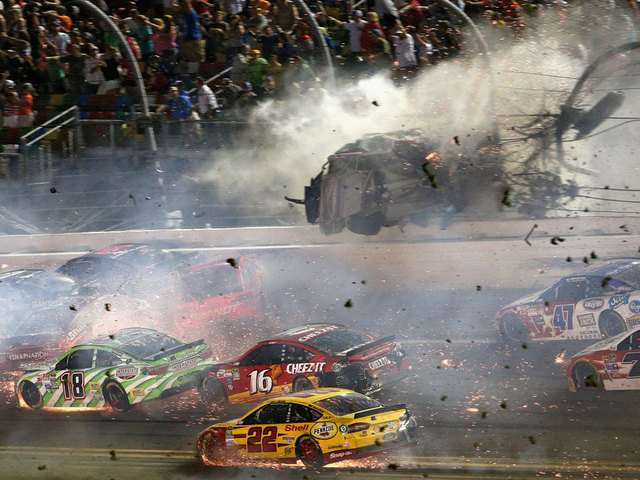Ryan Newman: ‘NASCAR got what they wanted’
"It's not really acceptable, I don't think," Dillon told reporters after being examined at the care center. "We've got to figure out something. Our speeds are too high, I think. I think everybody could get good racing with slower speeds. We can work at that, and then figure out a way to keep the cars on the ground. That's the next thing. We're fighting hard to make the racing good. I hope the fans appreciate that. We don't, but it's our job. You go out there and hold it wide open to the end and hope you make it through."
 |
| Austin Dillon rips the catch fence to shreds injuring 3 fans |
| Getty Images for NASCAR |
07/06/15 There are dog whistle references in every racing series, meant to shock and underscore seriousness.
When defending IndyCar series champion Will Power meant to forcefully assert last week at Auto Club Speedway that the racing conditions that preceded a last-lap crash that sent Ryan Briscoe tumbling were potentially lethal, he invoked "Las Vegas." Former series champion and two-time Indianapolis 500 winner Dan Wheldon was killed at Las Vegas Motor Speedway in a 2011 crash, the last IndyCar driver to die in the series.
As Sprint Cup driver Ryan Newman slogged through the Daytona International Speedway garage in the early morning Monday, a terrifyingly reminiscent accident scene behind him on the apron after a crash at the finish, he invoked "an event in 2001." Seven-time Sprint Cup champion Dale Earnhardt Sr. perished on the final lap of the 2001 Daytona 500, marking the last death by a driver in a series race.
Fourteen years later, the most dangerous form of NASCAR racing remains the most luridly popular with fans even though higher speeds and more spectacular accidents created by them are endangering both spectators and drivers.
"NASCAR got what they wanted. That's the end of it," Newman told USA TODAY Sports of restrictor plate racing. "Cars getting airborne, unsafe drivers, same old stuff. They just don't listen."
For the second time since 2013 there had been potential catastrophe at Daytona. That year, Kyle Larson's Xfinity Series car had tumbled across the fence, gashing a hole and spewing debris into the grandstands, injuring scores. And Monday morning, Austin Dillon's No. 3 Chevrolet, the number which Earnhardt had used to win six titles with Dillon's grandfather, Richard Childress, had warped three fence posts and injured five in a horrifying wreck that driver Jimmie Johnson was sure had killed Dillon.
Would this be the impetus for the change Newman deemed necessary?
"No, they had an event in 2001. They've had several events since then," he said. "They just don't pay attention to safety. Simple as that."
NASCAR and DIS officials proclaimed in the immediate aftermath that the catchfence had done its job. It was tattered, but it had kept Dillon's car from coming into the stands. Track president Joie Chitwood III would not comment on whether debris had again entered the seating bowl, as it did when Larson's engine was stuck in the mangled fence. Monday morning, fans were seated further from the crash site because of a reconfiguration as part of the Daytona Rising project.
Protecting fans should be not only a basic human concern but commercial concern for the series and its race tracks. But protecting the drivers should be the same. And although the sparse remnants of an upended race car that Dillon crawled from did save his life, NASCAR and other series continue to push the boundaries. Or get lucky.
IndyCar and NASCAR each received warnings, coded and real, the last two weeks. The question is whether the series listen. Or if they get another chance. Brant James/USA Today
